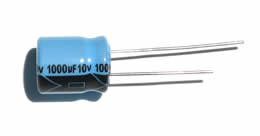Difference between Capacitor and Supercapacitor
Key Difference: Capacitor is a device that is used to store an electric charge. It is basically an arrangement of conductors. A Capacitor stores electrical energy directly as an electrostatic field is created between two metal "plates". A supercapacitor is also known as an ultracapacitor or a double-layer capacitor. A supercapacitor tends to differ from an ordinary capacitor due to its very high capacitance. A Supercapacitor has characteristics intermediate between general capacitors and batteries.
 A capacitor stores electrical charge and is capable of discharging it whenever required. It blocks DC and allows AC to pass through it. It is basically an arrangement of conductors. Due to its characteristics, a capacitor is widely employed in the formation of electronic circuits. Capacitor stores electrical energy directly, as an electrostatic field is created between two metal "plates". A capacitor is generally constructed using two metal plates or metal foils separated by an insulator known as a dielectric material. Any non-conducting substance can be used as a dielectric material. However, porcelain, mylar, teflon, mica, cellulose are generally preferred. Thus, a capacitor can be defined as an arrangement of two conducting surfaces separated by a dielectric medium.
A capacitor stores electrical charge and is capable of discharging it whenever required. It blocks DC and allows AC to pass through it. It is basically an arrangement of conductors. Due to its characteristics, a capacitor is widely employed in the formation of electronic circuits. Capacitor stores electrical energy directly, as an electrostatic field is created between two metal "plates". A capacitor is generally constructed using two metal plates or metal foils separated by an insulator known as a dielectric material. Any non-conducting substance can be used as a dielectric material. However, porcelain, mylar, teflon, mica, cellulose are generally preferred. Thus, a capacitor can be defined as an arrangement of two conducting surfaces separated by a dielectric medium.
A capacitor is defined by the type of dielectric and electrode material selected. It also defines the application of the capacitor. The dielectric material is the main substance that helps in storing the electrical energy. The measure of a device to store charge at a given voltage is defined by the term 'capacitance'. It can be connected in either series or parallel with an inductor in order to construct a resonance oscillating circuit for inductive heating.
 A supercapacitor is also known as an ultracapacitor or a double-layer capacitor. A supercapacitor tends to differ from an ordinary capacitor due to its very high capacitance. These capacitors have very high energy density in comparison to common capacitors. They are quite beneficial for hybrid vehicles.
A supercapacitor is also known as an ultracapacitor or a double-layer capacitor. A supercapacitor tends to differ from an ordinary capacitor due to its very high capacitance. These capacitors have very high energy density in comparison to common capacitors. They are quite beneficial for hybrid vehicles.
A supercapacitor was developed on a double layer mechanism in 1957. A supercapacitor can be used in the applications where batteries are used. They can be charged and discharged continuously. The main difference that exists between a capacitor and a supercapacitor is that supercapacitors are based on carbon technology. Due to this carbon technology, these capacitors are able to create a very large surface area. This area exists even with an extremely small separation distance. The effective thickness of the “dielectric” in a supercapacitor is exceedingly thin. Due to the porous nature of the carbon, the surface area remains to be extremely high and provides a very high capacitance.
Comparison between Capacitor and Supercapacitor:
|
|
Capacitor |
Supercapacitor |
|
Definition |
In capacitors, energy is stored in their electric field. |
A supercapacitor is also known as ultracapacitor or double-layer capacitor. A supercapacitor tends to differ from an ordinary capacitor due to its very high capacitance. |
|
Energy Density |
Comparatively low |
Comparatively very high |
|
Dielectric materials |
Dielectric material like ceramic, polymer films or aluminum oxide are used for the separation of the electrodes. |
Activated carbon is used as a physical barrier between the electrodes so that when an electrical charge is applied to the material a double electric field is generated. This electric field acts like a dielectric. |
|
Cost |
Comparatively cheap |
Comparatively expensive |
|
Advantages |
|
|
|
|
amount of time |
Image Courtesy: ladyada.net, depts.washington.edu









Add new comment